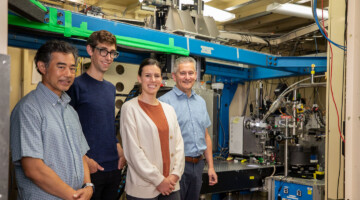In the superhard material, rhenium diboride, smaller grain size leads to greater yield strength (i.e., the amount of stress tolerated before permanent deformation). Because such transition-metal borides are extremely hard, metallic, and can be synthesized at ambient pressure, they have exciting potential for use in next-generation cutting tools. Read more »![]()
![]()
The Advanced Light Source is a U.S. Department of Energy scientific user facility at Lawrence Berkeley National Laboratory. Our mission is to advance science for the benefit of society by providing our world-class synchrotron light source capabilities and expertise to a broad scientific community.
ANNOUNCEMENT
ALS User Meeting, August 12–14
Don’t miss the 2024 ALS User Meeting, featuring invited speakers, hands-on workshops, tutorials, and two ALS–Molecular Foundry joint workshops. Registration for in-person attendance at the 2024 User Meeting is now closed. Registration for virtual attendance is open through August 9»

Caught in the Actinium
In this work, researchers demonstrated a macromolecular scaffold that combines an 8-coordinate synthetic ligand and a mammalian protein to characterize the solution and solid-state behavior of the longest-lived actinium isotope. The information could help design better cancer treatments. Read more »

Mechanistic Insight into a Viral-Factory Component
Recent protein-structure studies conducted at the ALS provided mechanistic insights into the function of a protein (σNS) involved in viral replication. Understanding these mechanisms will foster the development of therapeutic strategies against viruses that use σNS-like proteins to replicate. Read more »

ALS Computing Group Brings Machine Learning Models to Beamtimes around the World
The ALS computing team is developing tools to help users make the most of their beamtime and eliminate bottlenecks that currently exist. They have been traveling around the world and collaborating across facilities to develop advanced data processing solutions that will yield more meaningful data. Read more »
September Call for 2023 and 2024 Publications
All publications resulting from work done in whole, or in part, at the ALS must be recorded by the User Office for the Department of Energy (DOE). Please help ensure our records are complete by reporting your ALS publications, especially those published in 2023 and 2024. Read more »
Recent High-Impact Publications
- Lin, M.-K., J.A. Hlevyack, C. Zhao, P. Dudin, J. Avila, S.-K. Mo, C.-M. Cheng, P. Abbamonte, D.P. Shoemaker, and T.C. Chiang, “Unconventional Spectral Gaps Induced by Charge Density Waves in the Weyl Semimetal (TaSe4)2I,” Nano Letters 24, 8778?8783 (2024), doi:10.1021/acs.nanolett.4c02701 (July 8, 2024).
- He, Z., S.P. Poudel, S. Stolz, T. Wang, A. Rossi, F. Wang, S.-K. Mo, A. Weber-Bargioni, Z.Q. Qiu, S. Barraza-Lopez, T. Zhu, and M.F. Crommie, “Synthesis and Polymorph Manipulation of FeSe2 Monolayers,” Nano Letters 24, 8535?8541 (2024), doi:10.1021/acs.nanolett.4c01286 (July 5, 2024).
- Li, H., G. Wang, N. Ding, Q. Ren, G. Zhao, W. Lin, J. Yang, W. Yan, Q. Li, R. Yang, S. Yuan, J.D. Denlinger, Z. Wang, X. Zhang, L.A. Wray, S. Dong, D. Qian, and L. Miao, “Spectroscopic evidence of spin-state excitation in d-electron correlated semiconductor FeSb2,” Proceedings of the National Academy of Sciences of the United States of America 121, e2321193121 (2024), doi:10.1073/pnas.2321193121 (July 2, 2024).
- Sidhik, S., I. Metcalf, W. Li, T. Kodalle, C.J. Dolan, M. Khalili, J. Hou, F. Mandani, A.J. Torma, H. Zhang, R. Garai, J. Persaud, A. Marciel, I.A. Muro Puente, G.N. Reddy, A. Balvanz, M.A. Alam, C. Katan, E. Tsai, D. Ginger, D.P. Fenning, M.G. Kanatzidis, C.M. Sutter-Fella, J. Even, and A.D. Mohite, “Two-dimensional perovskite templates for durable, efficient formamidinium perovskite solar cells,” Science 384, 1227 (2024), doi:10.1126/science.abq6993 (June 14, 2024).
- Zhang, X., W. Zuo, S. Liu, C. Zhao, Q. Li, Y. Gao, X. Liu, D. Xiao, I. Hwang, Y. Ren, C. Sun, Z. Chen, B. Wang, Y. Feng, W. Yang, G. Xu, K. Amine, and H. Yu, “High-Energy Earth-Abundant Cathodes with Enhanced Cationic/Anionic Redox for Sustainable and Long-Lasting Na-Ion Batteries,” Advanced Materials2310659 (2024), doi:10.1002/adma.202310659 (June 13, 2024).
